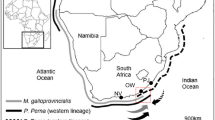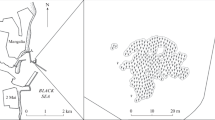Abstract
A major recruitment of the forcipulate asteroid Pisaster ochraceus was observed in September 1987 in the channel leading into Boca del Infierno, a semi-enclosed bay on the southeastern shore of Nootka Island, on the west coast of Vancouver Island, British Columbia, Canada. Newly settled recruits were observed at high densities subtidally in the channel (mean maximal density=1.23x104m-2) and at nearby sites. Subsequent surveys in 1988 to 1991 and size-frequency distributions of adults indicated strong yearly recruitment of P. ochraceus. Recruits of P. ochraceus were found on all available substrata, including hard and soft bottoms and on benthic algae. The initial food of the recruits included newly settled mussels (Mytilus sp.), snails and barnacles. Recruitment of the forcipulate Pycnopodia helianthoides was observed in 1987 to 1989 and in 1991, while recruitment of the spinulosan Dermasterias imbricata occurred only in 1988. High densities of planktonic bipinnaria larvae were found in the bay of Boca del Infierno in late May. We hypothesise that the high density population of adult P. ochraceus found in the channel of Boca del Infierno spawns synchronously and most of the resulting embryos and larvae are retained within the bay. This area may act as a “source” of larvae that then disperse locally. Post-recruitment mortality was estimated by comparing the density of recruits of P. ochraceus in 1987 with the numbers of juveniles presumed to be 1 yr old in 1988. Post-recruitment mortality was in excess of 97% with few individuals surviving to 1 yr. Moreover, even after the first year, mortality or emigration of the juveniles resulted in the almost complete loss of the 1-yr cohort at North Saavedra between 1988 and 1989. This study provides evidence that the P. ochraceus population in this area of Nootka Island may not be open, but may be regularly supplied from a “source” of larvae in the bay of Boca del Infierno. Post-settlement processes may, however, have significant effects on the local population, resulting in a poor correlation between the rate of recruitment and the incorporation of yr-1 + individuals into the adult population.
Similar content being viewed by others
References
Barker M. F. (1977). Observations on the settlement of the brachiolaria larvae of Stichaster australis (Verrill) and Coscinasterias calamaria (Gray) (Echinodermata: Asteroidea) in the laboratory and on the shore. J. exp. mar. Biol. Ecol. 30: 95–108
Barker, M. F. (1979). Breeding and recruitment in a population of the New Zealand starfish Stichaster australis (Verrill). J. exp. mar. Biol. Ecol. 41: 195–211
Barker, M. F., Nichols, D. (1983). Reproduction, recruitment and juvenile ecology of the starfish, Asterias rubens and Marthasterias glacialis. J. mar. biol. Ass. U.K. 63: 745–765
Cameron, R. A., Rumrill, S. S. (1982). Larval abundance and recruitment of the sand dollar Dendraster excentricus in Monterey Bay, California, USA. Mar. Biol. 71: 197–202
Chia, F.-S., Young, C. M., McEuen, F. S. (1984). The role of larval settlement behavior in controlling patterns of abundance in echinoderms. In: Engel, W., Clark, W. H. Jr., Fisher, A., Olive, P. J. W., Went, D. F. (eds.) Advances in invertebrate reproduction 3. Elsevier Science, Amsterdam, p. 409–424
Coe, W. R. (1956). Fluctuations in populations of littoral marine invertebrates. J. mar. Res. 15: 212–232
Connell, J. H. (1985). The consequences of variation in initial settlement vs. post-settlement mortality in rocky intertidal communities. J. exp. mar. Biol. Ecol. 93: 11–45
Denley, E. J., Underwood, A. J. (1979). Experiments on factors influencing settlement, survival, and growth of two species of barnacles in New South Wales. J. exp. mar. Biol. Ecol. 36: 269–293
Ebert, T. A. (1983). Recruitment in echinoderms. In: Jangoux, M., Lawrence, J. M. (eds.) Echinoderm studies 1. A. A. Balkema, Rotterdam, p. 169–203
Ebert, T. A., Russell, M. P. (1988). Latitudinal variation in size structure of the west coast purple sea urchin: a correlation with headlands. Limnol. Oceanogr. 33: 286–294
Feder, H. M. (1970). Growth and predation by the ochre sea star, Pisaster ochraceus (Brandt), in Monterey Bay, California. Ophelia 8: 161–185
Gaines, S., Brown, S., Roughgarden, J. (1985). Spatial variation in larval concentrations as a cause of spatial variation in settlement for the barnacle, Balanus glandula. Oecologia 67: 267–272
Gaines, S., Roughgarden, J. (1985). Larval settlement rate: a leading determinant of structure in an ecological community of the marine intertidal zone. Proc. natn. Acad. Sci. U.S.A. 82: 3707–3711
Galstoff, P. S., Loosanoff, V. L. (1939). Natural history and method of controlling the starfish (Asterias forbesi, Desor). Bull. Bur. Fish., Wash. 9: 75–132
Grosberg, R. K., Levitan, D. R. (1992). For adults only? Supplyside ecology and the history of larval biology. Trends Ecol. Evol. 7: 130–133
Hancock, D. A. (1958). Notes on starfish on an Essex oyster bed. J. mar. biol. Ass. U.K. 37: 565–589
Iwasa, Y., Roughgarden, J. (1986). Interspecific competiton among metapopulations with space-limited subpopulations. Theor. Popul. Biol. 30: 194–214
Jost, P., Rein, K. (1985). Migration from refuges: a stabilizing factor for a sea-star community. In: Keegan, B. F., O'Connor, B. D. S. (eds.) Echinodermata. Proc. Internatl. Echinoderm Conf., Galway, A. A. Balkema, Rotterdam, p. 523–528
Karlson, R. H., Levitan, D. R. (1990). Recruitment-limitation in open populations of Diadema antillarum: an evaluation. Oecologia 82: 40–44
Kenchington, R. A. (1977). Growth and recruitment of Acanthaster planci (L.) on the Great Barrier Reef. Biol. Conserv. 11: 103–118
Kenner, M. C. (1992). Population dynamics of the sea urchin Strongylocentrotus purpuratus in a central California kelp forest: recruitment, mortality, growth and diet. Mar. Biol. 112: 107–118
Keough, M. J., Downes, B. J. (1982). Recruitment of marine invertebrates: the role of active larval choices and early mortality. Oecologia 54: 348–352
Lambert, P. (1981). The sea stars of British Columbia. British Columbia Provincial Museum, Handbook 39, Victoria
Lewin, R. (1986). Supply-side ecology. Science, N. Y. 234: 25–27
Loosanoff, V. L. (1964). Variations in time and intensity of setting of the starfish, Asterias forbesi, in Long Island Sound during a twenty-five-year period. Biol. Bull. mar. biol. Lab., Woods Hole 126: 423–439
Mauzey, K. P. (1966). Feeding behavior and reproductive cycles in Pisaster ochraceus. Biol. Bull. mar. biol. Lab., Woods Hole 131: 127–144
Menge, B. A. (1974). Effect of wave action and competition on brooding and reproductive effort in the seastar, Leptasterias hexactis. Ecology 55: 84–93
Menge, B. A. (1975). Brood or broadcast? The adaptive significance of different reproductive strategies in the two intertidal sea stars Leptasterias hexactis and Pisaster ochraceus. Mar. Biol. 31: 87–100
Menge, B. A., Sutherland, J. P. (1987). Community regulation: variation in disturbance, competition, and predation in relation to environmental stress and recruitment. Am. Nat. 130: 730–757
Menge, J. L., Menge, B. A. (1974). Role of resource allocation, aggression and spatial heterogeneity in coexistence of two competing intertidal starfish. Ecol. Monogr. 44: 189–209
Paine, R. T. (1966). Food web complexity and species diversity. Am. Nat. 100: 65–75
Paine, R. T. (1974). Intertidal community structure. Experimental studies on the relationship between a dominant competitor and its principal predator. Oecologia 15: 93–120
Paine, R. T. (1976). Size-limited predation: an observatinal and experimental approach with the Mytilus-Pisaster interaction. Ecology 57: 858–873
Paine, R. T. (1980). Food webs: linkage, interaction strength and community infrastructure. J. Anim. Ecol. 49: 667–685
Pearse, J. S., Hines, A. H. (1987). Long-term population dynamics of sea urchins in a central California kelp forest: rare recruitment and rapid decline. Mar. Ecol. Prog. Ser. 39: 275–283
Pulliam, H. R. (1988). Sources, sinks, and population regulation. Am. Nat. 132: 652–661
Pulliam, H. R. (1954). Growth of the purple seastar. Oyster Bull. 5: 11–13
Rasmussen, E. (1973). Systematics and ecology of the Isefjord marine fauna (Denmark). Ophelia 11: 1–507
Reichelt, R. E., Bradbury, R. H., Moran, P. J. (1990). Distribution of Acanthaster planci outbreaks on the Great Barrier Reef between 1966 and 1989. Coral Reefs 9: 97–103
Roughgarden, J., Gaines, S., Possingham, H. (1988). Recruitment dynamics in complex life cycles. Science, N. Y. 241: 1460–1466
Roughgarden, J., Iwasa, Y. (1986). Dynamics of a metapopulation with space-limited subpopulations. Theor. Popul. Biol. 29: 235–261
Roughgarden, J., Iwasa, Y., Baxter, C. (1985). Demographic theory for an open marine population with space-limited recruitment. Ecology 66: 54–67
Rowley, R. J. (1989). Settlement and recruitment of sea urchins (Strongylocentrotus spp.) in a sea-urchin barren ground and a kelp bed: are populations regulated by settlement or post-settlement processes? Mar. Biol. 100: 485–494
Rowley, R. J. (1990). Newly settled sea urchins in a kelp bed and urchin barren ground: a comparison of growth and mortality. Mar. Ecol. Prog. Ser. 62: 229–240
Rumrill, S. S. (1987). Differential predation upon embryos and larvae of temperate Pacific echinoderms. Ph.D. Thesis, University of Alberta, Edmonton
Rumrill, S. S. (1988). Temporal and spatial variability in the intensity of recruitment of a sea star: frequent recruitment and demise. Am. Zool. 28(4): 123A
Rumrill, S. S. (1989). Population size-structure, juvenile growth, and breeding periodicity of the sea star Asterina miniata in Barkley Sound, British Columbia. Mar. Ecol. Prog. Ser. 56: 37–47
Stickle, W. B., Foltz, D. W., Katoh, M., Nguyen, H. L. (1991). Genetic structure in five species of seastars (Echinodermata: Asteroidea) from Alaska. Am. Zool. 31(5): 29A
Strathmann, M. F. (1987). Phylum Echinodermata, Class Asteroidea. In: Strathmann, M. F. (ed.) Reproduction and development of marine invertebrates of the northern Pacific Coast. University of Washington Press, Seattle, p. 535–555
Strathmann, R. (R.) (1978a). Length of pelagic period in echinoderms with feeding larvae from the northeast Pacific. J. exp. mar. Biol. Ecol. 34: 23–27
Strathmann, R. R. (1978b). Larval settlement in echinoderms. In: Chia, F. S., Rice, M. E. (eds.) Settlement and metamorphosis of marine invertebrate larvae. Elsevier/North-Holland, New York, p. 235–246
Stephenson, T. A., Stephenson, A. (1961). Life between tide-marks in North America. IVa. Vancouver Island, I. J. Ecol. 49: 1–29
Thorson, G. (1966). Some factors influencing the recruitment and establishment of marine benthic communities. Neth. J. Sea Res. 3: 267–293
Underwood, A. J., Denley, E. J. (1984). Paradigms, explanations, and generalizations in models for the structure of intertidal communities on rocky shores. In: Strong, D. R., Simberloff, D., Abele, L. G., Thistle, A. B. (eds.) Ecological communities: conceptual issues and the evidence. Princeton University Press, Princeton, p. 151–180
Underwood, A. J., Fairweather, P. G. (1989). Supply-side ecology and benthic marine assemblages. Trends Ecol. Evol. 4: 16–20
Young, C. M. (1990). Larval ecology of marine invertebrates: a sesquicentennial history. Ophelia 32: 1–48
Zann, L., Brodie, J., Vuki, V. (1990). History and dynamics of the crown-of-thorns starfish Acanthaster planci (L.) in the Suva area, Fiji. Coral Reefs 9: 135–144
Author information
Authors and Affiliations
Rights and permissions
About this article
Cite this article
Sewell, M.A., Watson, J.C. A “source” for asteroid larvae?: recruitment of Pisaster ochraceus, Pycnopodia helianthoides and Dermasterias imbricata in Nootka Sound, British Columbia. Marine Biology 117, 387–398 (1993). https://doi.org/10.1007/BF00349314
Received:
Accepted:
Issue Date:
DOI: https://doi.org/10.1007/BF00349314




